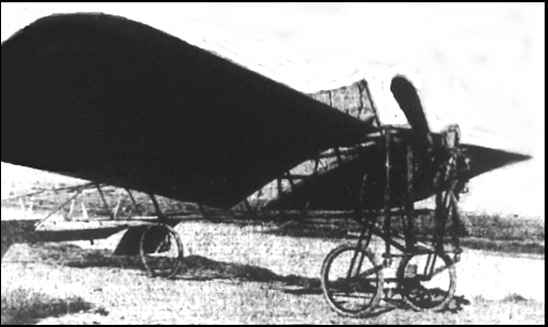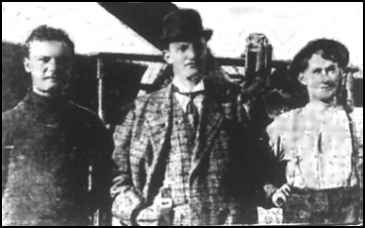
THE SAN FRANCISCO CALL, THURSDAY MARCH 3, 1910 AVIATOR PLANS AERIAL EXHIBITION in LIGHTEST MONOPLANE YET BUILT A successful flying machine that has been built at Richmond by two young men of that town and in which noe of them will give a free exhibition next Sunday |
 |
|
AIRSHIP TO MAKE INITIAL FLIGHT New Machine Invented by Richmond Men Will Be Flown Sunday Plans Made for Public Aerial Contest to Be Held Across the Bay The lightest aeroplane yet constructed will make its initial flight Sunday noon at Richmond, Contra Costa county. The machine has been made by Clifford O'Brien and J. W. Hudson. When its wings are on and with its supply of gasoline |
 Clifford O'Brien (on the left), L. W. Coffee and J. W. Hudson. O'Brien and Hudson are the two young men who have built the Rich- mond monoplane in which O'Brien will make a flight next Sunday. Coffee is an enterprising businessman of Richmond, who is making the arrangements for the event. Hudson is a young mechanic, who has constructed the engine for the flier. |
|
the entire weight, less that of the operator, will be but 350 pounds. The Paulhan machine weighed
about three times as much when Paulhan exhibited in San Mateo county recently. To carry but one third of the
Paulhan flier weight the O'Brien-Hudson monoplane has. two thirds the amount of horsepower that so successfully
was employed by Paulhan. L. W. Coffee of Richmond. has made arrangements for the flight Sunday. He is confident that success will be the result of the trial and that a new chapter inaviation is about to be opened. The ground selected for the starting place is the central |
Richmond tract on Cutting boulevard, close to the site selected for the Pullman
car shops. All San Pablo cars pass the spot and visitors will find it an enjoyable ride to go to Richmond and
will reach the aviation field without difficulty. . The monoplane has been put in fine trim. Clifford O'Brien will be the aviator. The monoplane is 25 feet long and 26 feet over all, including wings. The motor is a five cylinder rotary that has been made by O'Brien and Hudson. The engine weighs but SO pounds, but supplies 36 horsepower. Paulhan had a seven cylinder motor, and 50 horsepower. The Richmond monoplane has a seven foot |
propeller. The general scheme of construction resemblesthat of the Bleriot aeroplane,
but the framework is triangular instead. of square in shape. Each of the wings has 12 square feet of space. A large number of visitors went to the building in Richmond yesterday in which the final touches were being placed by the inventors on their creation. Great interest has been manifested by devotees of aviation on both sides of the bay. Last evening Manager L. W. Coffee said: "We anticipate giving a fine free exhibition. Every one will be welcome. Every one should have a good time in addition to seeing a novel and striking spectacle." |
|
San Francisco Chronicle San Francisco, CA Dec. 21, 1909, Transcribed by Kurt Bodden, 2-1-10 The monster wings, or planes, of the ship are 38 feet from tip to tip, and the total length is 35 feet. The wooden structure is of white spruce and the frames and gear work of the engine are of nickel, steel and aluminum. The propeller, of white spruce, is 7 feet from tip to tip and has two blades, which can be made to revolve at the rate of 1,200 revolutions a minute. When demonstrated last evening, the backward pressure of air was terrific, and it was necessary to have the ship securely anchored to keep it from moving. The engine has 36 horsepower. The total weight of the engine is 124 pounds and the total weight of the ship is 600 pounds. Ten gallons of gasoline can be carried and one gallon of oil. |
|
the Accident Being Peculiar in that One Crashed Upon the Other Daily Journal and Tribune, Knoxville, Tennessee: July 2, 1910, Transcribed by Bob Davis - 9-4-03 Clifford O'Brien, in a Farman biplane, had successfully circled the Emeryville track several times, when a sudden gust of wind caught him as he passed the grandstand. His aeroplane turned over and crashed to the ground, a distance of 100 feet. As he extracted himself from the wreck, he saw the Curtiss machine of Samuel H. Smith swooping down upon him. O'Brien barely had time to jump as the Smith aeroplane caught in the same treacherous puff of wind, crashed down upon the Farman machine. Both aeroplanes were totally wrecked. When Smith was dragged out it was found that one of his ribs was broken and that he was badly hurt." Bob Davis |
|
(11-27-10), you will find about 16 links. Only a few are relevant. |
|
|
|
If you have any more information on this Early Flier, please contact me. E-mail to Ralph Cooper Back 

|